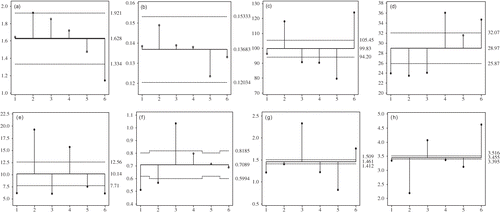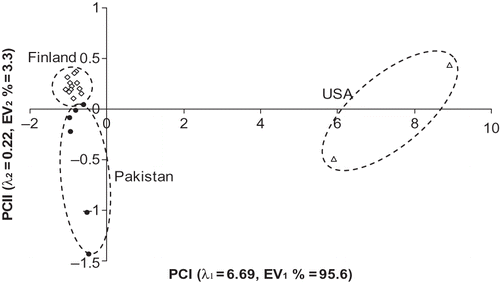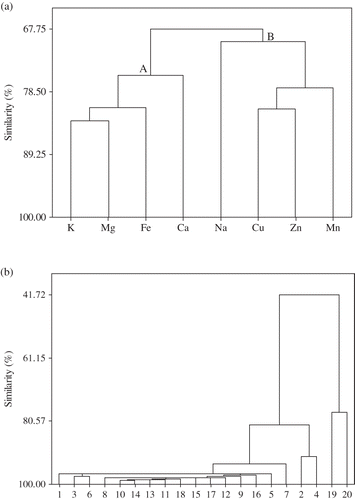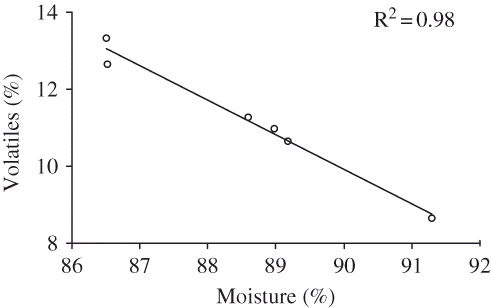Abstract
Six strawberry samples, commercially grown in Pakistan, were studied for physicochemical properties. All samples have high level of water and low contents of ash and volatile compounds. The berry was found to be a good source of potassium (1.14–1.93 g/kg), magnesium (0.12–0.15 g/kg), calcium (79.59–124.11 mg/kg) and sodium (23.51–36.03 mg/kg). The lead and cadmium contents were below the detection limits (1.0 ± 0.1 μg/l for lead and 0.1 ± 0.01 μg/l for cadmium). Principal component analysis and cluster analysis were found to be good statistical tools for the evaluation of the compositional variations with respect to geographical origin.
INTRODUCTION
Strawberries are unique in their taste and flavor and are excellent dietary source of ascorbic acid, potassium, and other secondary metabolites. It can be cultivated on less fertile soil, often acidic; therefore promoting the uptake of higher amount of heavy metals. Hence, mature strawberry fruit is a good source of minerals. Excess of some metals particularly lead and cadmium can cause serious illness. Therefore, the contents of these elements should be monitored on regular basis, particularly in fruit which is the edible part of the plant. Very limited work on the mineral composition of strawberry was reported in literature.[Citation1–5] More studies were carried out on glucosides, phenolic compounds, iridoids, and textural properties of strawberries.[Citation6–11] Similar to other countries, interest in plants of nutritional importance has increased in Pakistan in recent years. After the devastation of the banana plantation over an area of about 50,000 acres, growers of district Khairpur were in search of a crop, which could fetch them lucrative return just as banana. Some growers have tried cultivation of strawberry during the Rabi 2004 season. It was the first ever cultivation of the exotic fruit crop in this part of Sindh province.[Citation12] Its varieties grown in Pakistan are Chandelier, Corona and Stuff.[Citation13] These are mostly sour and small in size. Although Pakistan's climatic condition is suitable for its cultivation. But it is still growing on small scale in various regions of lower altitudes since last few years. It is cultivated in November, and gives fruit from April to May. The fruit maturity period is short and ranges from 30–40 days.[Citation12] No detailed study concerning to mineral properties of strawberries cultivated in Pakistan was performed until now.
The aim of the present study was two-fold. The main objective was to evaluate quality of strawberry fruit cultivated in Pakistan based on the heavy metals content. Since the consumer desires products of nutritional importance free from potentially harmful constituents; therefore, emphasize was given on the trace metallic elements in strawberries. Beside these determinations, some physical properties were also investigated. The secondary aim of the study was to compare results obtained from samples cultivated in Pakistan with those previously reported from other parts of the world. The development of techniques to determine geographic origin is highly desirable due to two reasons: firstly, laws implement labeling of the geographic origin of agricultural products. Secondly, producers have begun to advertise their high-quality agricultural products by labeling the geographic origin for their economic advantage or to protect their product from deceptive labeling. In 1992, the European Union created systems known as PDO (Protected Designation of Origin), PGI (Protected Geographical Indication) and TSG (Traditional Specialty Guaranteed) to promote and protect regional food products.[Citation14] Keeping these points in mind, multivariate statistics was applied on the mineral data for the separation of strawberries of different geographical origins.
MATERIALS AND METHODS
Sampling
Fresh ripe samples of strawberry fruit cultivated in Sindh and Punjab, two major provinces of Pakistan, were purchased from the local markets during June 2007. Three samples named Panu Aqil, Khairpur Mirs and Gambut belongs to Sindh province, the other three samples, Mir Pur Dhamky Lahore, Lahore and Rawaldam are grown and utilized in the Pubjab province. Sampling (2 kg, of each variety) was quite representative since the districts from where the variety examined were scattered throughout the city. The fruits were kept in cooled bags for transport to the laboratory. The fruits were washed and air dried to remove all foreign matter such as dust, dirt, immature and damaged fruits. Only the fresh edible portions were considered for the analysis whereas bruised or rotten parts were removed. The samples were stored in a freezer at −3°C for subsequent analysis.
Proximate Composition
Moisture, volatile matter and ash content were determined using Thermogravimetric analyzer (TGA–2000, Navas Instruments, Spain). A constant gas flow was set in all the tests to obtain a low–noise signal. The precision of microbalance and thermocouple for mass and temperature measurements are ±0.2 mg and ±1°C, respectively.
Loss in sample mass with the increase in temperature was measured during thermal decomposition.[Citation15] For moisture determination, the sample was heated at a rate of 12°C min−1 to 105°C in nitrogen atmosphere and held at this temperature to remove water content until a constant weight was obtained. The percentage of water content was calculated by taking into account the difference between initial mass and the constant mass at 105°C. The percentage of volatiles was determined at 950°C with a constant heating for 7 min in nitrogen environment to ensure complete devolatilisation. The ramp rate during heating was 16°C min−1. The sample was then retained at 500°C for 10 min. In an air flux of 20 ml min−1, the furnace temperature was increased from ambient temperature to constant temperature of 550°C with the ramp rate of 16°C min−1 for the determination of ash content. Thermal oxidative degradation was measured by continuous monitoring the weight of the sample as a function of temperature until a constant weight was obtained. The results for volatiles and ash were reported on fresh weight basis.
Sample Preparation and Treatment
Sub–sample (2 g wet mass, each) were taken randomly from the composite sample and digested in a mixture of 65% HNO3 (3 ml) and 30 % H2O2 (2 ml) in closed PTFE vessels of CEM MDS–200 microwave (CEM, USA), digestion system. The digested samples were diluted to 25 ml in volumetric flask and stored in polyethylene vessels before analysis. For Ca and Mg determinations, the samples were diluted with 0.1% (w/v) La solution.[Citation16]
Standards
Standard solutions of heavy metals, lead (Pb), cadmium (Cd), copper (Cu), potassium (K), sodium (Na), magnesium (Mg), calcium (Ca), iron (Fe), manganese (Mn), and zinc (Zn) were purchased from Merck (Darmstadt, Germany). The stock solutions were prepared from the individual 1000 mg/l standards (Merck), in 0.1 N HNO3. Working standards were prepared from the previous stock solutions.
Flame Atomic Absorption Analysis
Analyses of heavy metals of interest were performed by Perkin Elmer atomic absorption spectrophotometer (PE–3300) using the hollow cathode lamps. The flame technique was employed for Ca, Mg, K, Na, Fe, Zn, Cu, Mn, and graphite furnace for Cd and Pb. For the determination of metals, two solutions were prepared for each sample and minimum of three separate readings were taken for each solution. The means values were used to calculate the concentrations.
Quality Assurance
To establish the accuracy, reliability and reproducibility of the analytical results, all the reagents used were of analytical grade. Volumetric glassware employed for solution preparation were of class “A” quality. The glassware were washed and rinsed as described in ref.[Citation17] Double distilled water was used for solution preparation and dilution purpose. The standards used for atomic absorption spectrophotometer were of May & Baker, Ltd., England. Blank determinations were used to correct the instrument readings. Two commercial reference materials Spectroquant CombiCheck 30 and CombiCheck 40 (Darmstadt, Germany) were used as the quality control samples.
Statistical Data Analysis
Data were statistically analyzed to investigate the variations in proximate and mineral contents in all samples. Data was subjected to Analysis of Means (ANOM) to determine if the sample means are equal and at the same time visually determine where the difference is coming from. The Hierarchical cluster analysis was performed using single linkage method and Euclidian distance of samples. All statistical measurements were performed using statistical software Minitab version 15.
RESULTS AND DISCUSSION
Physical and Proximate Composition
All samples of strawberry were orange red in colour having rough surface. The fruit of Panu Aqil, Gambut and Rawaldam were conic in shape while the remaining samples were globose conic with distinctively round tip. The average weight of individual samples was ranging from 8.16 to 12.79 g with a mean value of 11.26 g. The relatively high water content was found in all samples (86.51–91.29 g/100 g, average = 88.51 g/100 g). The amount of volatiles and ash were ranging from 8.65–13.32 g/100 g (average: 11.25 g/100 g), and 0.05–0.87 g/100 g (average: 0.24 g/100 g), respectively. Volatile compounds are the most important in producing the characteristic aroma and the distinctively fruity flavour in strawberry.[Citation18] shows the physical and proximate composition of the varieties cultivated in Pakistan.
Table 1 Physical and proximate composition of strawberries
Mineral Nutrient Content
The mineral contents of strawberry samples are shown in . The results of the analyses are established to give nutrient values per kg of used portion of fresh sample. Potassium was the main mineral element found in all samples. Its range of variation was 1.14–1.93 g/kg when taken all samples into account. Mg ranged from 0.12–0.15 g/kg, Ca from 79.59–124.11 mg/kg, Na from 23.50–36.03 mg/kg, and Fe from 6.04–19.27 mg/kg. Concentrations of Cu, Zn and Mn were lower; the range of variation was 0.51–1.03, 0.82–2.33, and 2.19–4.62 mg/kg, respectively. The lead and cadmium content were found to be below the detection limit (1.0 μg/l for Pb and 0.1 μg/l for Cd) in all samples. This concluded that the strawberry fruit cultivated in Pakistan is free from the toxic level of these pollutants. The reported maximum levels for lead and cadmium in fruit are 0.1 mg/kg and 0.05 mg/kg, respectively.[Citation19]
Table 2 Mineral Elemental composition in different samples of strawberries
Analysis of means (ANOM) was performed on mineral contents of strawberry samples and the differences among the samples were observed (). Potassium content was significantly different in sample 6 (Sharqpur Road Lahore) with p < 0.05. No significant variation was observed for magnesium content in all samples. Other metals are in significantly variable quantity in all samples (p < 0.05)
Figure 1 One–Way Normal Analysis of Means (ANOM) for mineral composition of strawberry fruit Inset provides ANOM for: (a) K, (b) Mg, (c) Ca, (d) Na, (e) Cu, (f) Fe, (g) Mn, (h) Zn. Sample identification: 1: Panu Aqil; 2: Khairpur Mirs; 3: Gambut; 4: Mirpur Dhamkay Lahore; 5: Sharqpur Road Lahore; and 6: Rawaldam.

The mineral contents of strawberry fruit are comparable with the previous results[Citation16,Citation20]with minor variations as shown in . The characteristic metal, which provides the distinguishable basis to Pakistani varieties from others is iron. As specified by , all Pakistani varieties showed high concentration of Fe in comparison to others. The low content of calcium in Pakistani samples revealed that the plant uptake of this metal is slightly lower than that of potassium and magnesium. Low Ca content deteriorates the firmness and shelf life of fruit.[Citation21,Citation22] This dissimilarity is probably due to the difference in the environmental conditions and chemistry of the soil.
Table 3 Contents of minerals in strawberries in different studies as mean and range (in parenthesis)
Correlation Analysis
shows the significant inverse correlation between water content and volatile compounds (p < 0.001); the correlation between other parameters was less strong (p > 0.05). It is evident from the literature that high volatiles are the indicator of fungal activity and the spoilage fungi in acidic environment can produce mycotoxins, which prevents the food from being used.[Citation23] In our studies, high water content and low volatiles showed the freshness of the berries with minimum possibility of fungal activity.
Principal Component Analysis (PCA)
The mineral data of strawberry fruit cultivated in Pakistan were compared with the same of grown in Finland and USA.[Citation16,Citation20] The results of PCA calculations of the fruit samples of three different geographical origins of the world are compiled in . In this analysis, the original variables are presented as linear combinations of principal components. The values of principal components are component scores. The linear coefficients are called the component loading, i.e. the correlation coefficients between the original variables and the principal components. Considering the eigenvalues, the distribution of samples is illustrated in bi–plot of PCI versus PCII, which account for more than 99% of the total variance. The PCA explained 95.6% of the total variability for first component (PCI) and was predominantly a function of potassium, magnesium, calcium, iron, copper, zinc and manganese, while the second component PCII (3.3% of the variance) is made up of iron. The third component (PCIII) explained only 0.4% of the variance and hence not considered here.
Table 4 Component matrix for compositional parameters (significant PCA components are shown in bold)
In , the samples of three different geographical origins are clearly separated with each other. The strawberries samples cultivated in Pakistan are separated in lower left portion (circles), in the upper left half the consistency were found in the properties of samples grown in Finland (diamond). “Allstar” and “Honeoye” the two strawberry varieties, cultivated by US Department of Agriculture, Beltsville, are separated in right portion of the plot (triangle). As it is shown in , similar locality of the regional samples could be a reason for lack of big differences in the chemical composition of the dessert fruit.
Figure 3 Bi–plot for object scores of the first two principal vectors of 20 strawberry samples. Regional differences are illustrated by clusters of points.

It is evident from that a better discrimination might be obtained, if a large sample size from different geographical origins is available.
Cluster Analysis
The dendrogram of cluster variables allows classifying the elements into two main groups with good correlations between the metals . Group A consists of K, Mg, Fe, and Ca, as the soil may enrich these four elements, while group B consisting of Na, Cu, Zn, and Mn. Among these the later three are the well–known pollutants in urban soils. The fact that they are separated from group A, demonstrates that these elements share some common features which prevent them to accumulate in the fruit. The dendrogram of cluster observations, represents the similarity between the samples. As the figure showed, a cluster was formed by samples 8–18 of origin Finland, the samples of USA (samples 19 and 20) were separated by a distinct cluster. The samples cultivated in Pakistan comprises the grouping of samples No. 1, 3, and 6 (Panu Aqil, Gambut, and Rawal Dam), joined to samples 2 and 4 (Khairpur Mirs and Mir Pur Dhamkay Lahore) via sample No. 7, a Finland sample, having high Fe content, comparable to Pakistani samples and be at variance from Finland samples. is a good representation of the data separation according to geographical origin.
Figure 4 Dendrogram resulting from hierarchical cluster analysis. (a) Cluster variables; (b) cluster observation. Sample Identification 1: Panu Aqil; 2: Khairpur Mirs; 3: Gambut; 4: Mirpur Dhamky Lahore; 5: Sharqpur Road Lahore; 6: Rawaldam; 7: Senga PP; 8: Senga E; 9: Senga SW; 10: Senga; 11: Jonsok; 12: Korona; 13: Polka; 14: Honeoye; 15: Bounty; 16 (Polka–OR; 17: Honeoye–OR; 18: Jonsok–OR; 19: Allstar; and 20: Honeoye.

CONCLUSION
All the strawberry samples studied were safe to eat and contained essential components, although the variations in physicochemical properties between the samples were observed. The major mineral elements were found as K, Ca, Mg, and Na. There is no single variety of strawberry, which contains high level of all the mineral nutrients. Samples from Khairpur Mirs have high potassium and iron contents while Rawaldam samples were rich with calcium. The results were also compared with the reported data by applying multivariate analysis. It was showed that the samples could be clustered reasonably into different groups, which correspond with variation of correlation between the metals and distribution of metals in strawberry fruit in different regions.
REFERENCES
- Bednarek , W. , Tkaczyk , P. and Dresler , S. 2006 . Content of heavy metals as a criterium of the quality of strawberry fruit and soil properties . Polish J Soil Science , 39 ( 2 ) : 165 – 174 .
- Ozcan , M. M. and Hacıseferogullar , H. 2007 . The Strawberry (Arbutus unedo L.) fruits: Chemical composition, physical properties and mineral contents . Journal of Food Engineering , 78 : 1022 – 1028 .
- Tagliavini , M. , Baldi , E. , Lucchi , P. , Antonelli , M. , Sorrenti , G. , Baruzzi , G. and Faedi , W. 2005 . Dynamics of nutrients uptake by strawberry plants (Fragaria X Ananassa Dutch.) grown in soil and soilless culture . Europ. J. Agronomy , 23 : 15 – 25 .
- Cayuela , J.A. , Vidueira , J.M. , Albi , M.A. and Gutierrez , F. 1997 . Influence of the ecological cultivation of strawberries (Fragaria X Ananassa Cv. Chandler) on the quality of the fruit and on their capacity for conservation . J. Agric. Food Chem. , 45 : 1736 – 1740 .
- Wang , S. Y. and Lin , S. S. 2002 . Composts as soil supplement enhanced plant growth and fruit quality of strawberry . J. Plant Nutrition , 25 ( 10 ) : 2243 – 2259 .
- Kus , S. , Gogus , F. and Eren , S. 2005 . Hydroxymethyl Furfural Content of Concentrated Food Products . International Journal of Food Properties , 8 ( 2 ) : 367 – 375 .
- Karikas , G.A. and Giannitsaros , A. 1990 . Phenolic glucosides of Arbutus, unedo leaves . Plantes Medicinales et Phytotherapie , 24 ( 1 ) : 27 – 30 .
- Karikas , G. A. 1993 . Iridoids from Arbutus unedo . Fitoterapia , 64 ( 2 ) : 187
- Llusia , J. and Penuelas , J. 2000 . Seasonal patterns of terpene content and emission from seven Mediterranean woody species in field conditions . American Journal of Botany , 87 ( 1 ) : 133 – 140 .
- Sera , A. D. and Franco , M. A. 1999 . Aroma characterization of Sardinian strawberry tree (Arbutus unedo L.) honey . Italian Journal of Food Science , 11 ( 1 ) : 47 – 56 .
- Kopjar , M. , Pilizota , V. , Hribar , J. , Tiban , N.N. , Subaric , D. , Babic , J. and Pozrl , T. 2008 . Influence of trehalose addition on instrumental textural properties of Strawberry pastes . International Journal of Food Properties , 11 ( 3 ) : 646 – 655 .
- Bhambhro, S.A. Cultivation of strawberry in Khairpur. 2004 http://www.dawn.com/weekly/science/archive/040403/science12.htm (http://www.dawn.com/weekly/science/archive/040403/science12.htm) (Accessed: 1 February 2008 ).
- Khushk, A.M.; Memon, A. Strawberry cultivation. 2004 http://www.pakissan.com/english/advisory/strawberry.cultivation.shtml (http://www.pakissan.com/english/advisory/strawberry.cultivation.shtml) (Accessed: 1 February 2008 ).
- European Commission. EU agricultural product quality policy. 2006 http://ec.europa.eu/agriculture/quality/schemes/index_en.htm (http://ec.europa.eu/agriculture/quality/schemes/index_en.htm) (Accessed: 1 February 2008 ).
- Garcia–Ibanez , P. , Sanchez , M. and Cabanillas , A. 2006 . Thermogravimetric analysis of olive–oil residue in air atmosphere, Fuel Processing Technology , 87 ( 2 ) : 103 – 107 .
- Hakala , M. , Lapvetelainen , A. , Huopalahti , R. , Kallio , H. and Tahvonen , R. 2003 . Effect of varieties and cultivation conditions on the composition of strawberries . Journal of food composition and Analysis , 16 : 67 – 80 .
- Khan , N. and Wahab , F. 2005 . A glassware cleaning mixture . Bulgarian J. Chem. Educ. , 14 ( 6 ) : 518 – 519 .
- Watson , R. , Wright , C. J. , McBurney , T. , Taylor , A. J. and Linforth , RST. 2002 . Influence of harvest date and light integral on the development of strawberry flavour compounds Journal of Experimental Botany . Fruit Development and Ripening Special Issue , 53 ( 377 ) : 2121 – 2129 .
- Butterworth, J.; Bugang, W.; China, Peoples Republic of FAIRS Product specific maximum levels of contaminants in foods 2006, GAIN Report Number: CH6064, 2006 http://www.fas.usda.gov/gainfiles/200608/146208660.doc (http://www.fas.usda.gov/gainfiles/200608/146208660.doc) (Accessed: 12 February 2009 ).
- Tahvonen , R. 1993 . Contents of selected elements in some fruits, berries and vegetables on the Finnish market in 1987––1989 . Journal of Food Composition and Analysis , 6 : 75 – 86 .
- Lieten , F. and Marcelle , R. 2001 . Acta Horticulturae, Second International Strawberry Symposium . 348 : 299 – 306 .
- MacNaeidhe, F.S. The Effect of Nutrition on the Flavour of Strawberries Grown under Protection http://www.teagasc.ie/research/reports/horticulture/4458/eopr-4458.htm (http://www.teagasc.ie/research/reports/horticulture/4458/eopr-4458.htm) (Accessed: 1 February 2008 ).
- Magan , N. and Evans , P. 2000 . Volatiles as an indicator of fungal activity and differentiation between species, and the potential use of electronic nose technology for early detection of grain spoilage . Journal of Stored Products Research , 36 : 319 – 340 .
